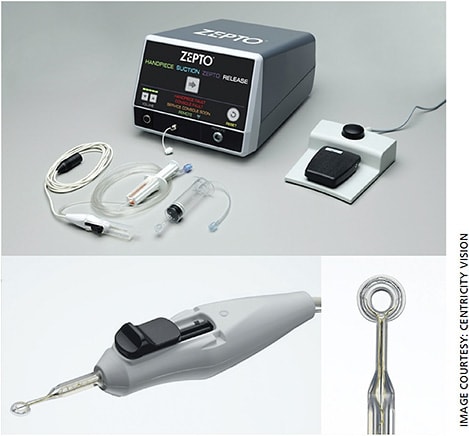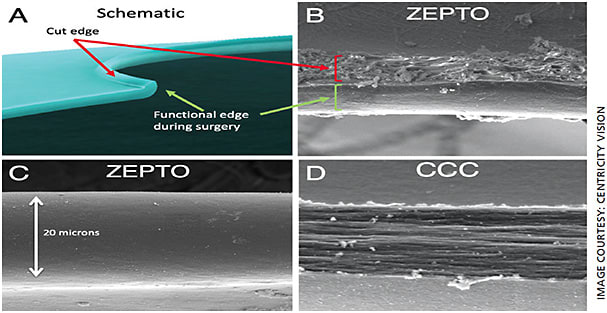Thanks to innovations in intraoperative equipment and IOLs, today’s cataract surgery patients have much higher expectations compared to a decade ago. To keep up with these expectations, cataract surgeons must adapt to and adopt these advances that help us to achieve better and more consistent outcomes.
One such technology is the Zepto Precision Cataract Surgery system (Centricity Vision), which has become a mainstay in my practice during the last 3 years. It incorporates a marketable offering to patients by being the latest automated capsulotomy technology available while providing a boost to success rates with advanced technology IOLs.
PREVIOUS OPTIONS
Historically, the manual capsulorhexis was a surgeon’s best shot at centering the capsulotomy on the visual axis. However, we have all experienced eccentric capsulotomies from this approach that can impact IOL overlap. New technologies have been created since then to aid in the creation of a reproducible circular, centered capsulotomy. These types of capsulotomies help surgeons achieve 360° of capsular overlap (important for avoiding lens tilt) and aid in centering the lens in the correct position within the capsule. However, each practice must weigh the costs of these technologies against the benefits.
Femtosecond laser-assisted cataract surgery (FLACS) is an example of this. As Garvis et al showed in Romanian Journal of Ophthalmology in 2017, compared to the manual approach, FLACS creates a more reproducible capsulotomy in terms of diameter and uniformity. This benefit is a major reason why surgeons choose FLACS. However, the costs include the footprint of the machine, capital requirements and disruption to standard surgical workflow.
As Asbell et al showed in a 2014 study in Ophthalmology, another concern of FLACS capsulotomies has been the rougher edges of the capsulotomy buttons when compared to a manual continuous curvilinear capsulorhexis (CCC). It has been theorized that these micro-tears could lead to weaker areas in the capsulotomy, thus leading to anterior capsular tears. However, the technology offering is still an attractive feature to many patients and surgeons due to its ability to complete multiple steps in the surgery, including astigmatism correction.
CENTRICITY’S SOLUTION
The Zepto Precision Cataract Surgery System is an alternative technology that has gained favor in the last couple of years due to its ability to avoid many of the disadvantages of FLACS. Centricity Vision’s system is a small-footprint console that attaches to a disposable handpiece (Figure 1). The handpiece is comprised of a nitinol ring that is housed within a silicone cup. The device is inserted into the eye through any 2.2-mm or greater incision and allowed to applanate against the anterior capsule. Gentle suction is applied to the capsule, and 12 micropulses of energy are applied over 4 milliseconds.

The result is a consistently round, exceptionally strong capsulotomy that is made during the normal steps of cataract surgery, rather than in a two-step procedure such as FLACS. Most importantly, the capsulotomy can be centered on the patients visual axis rather than the center of the capsule (optical axis).
A STRONGER CAPSULOTOMY
Studies have shown the benefits of a Zepto capsulotomy. Thompson et al compared the strength of Zepto to manual CCC and FLACS in 2016 and showed that the Zepto capsulotomy was 3.1 times stronger than FLACS and 4.1 times stronger than manual CCC. Clinically, this has significant implications. The anterior capsulotomy edge stretches and strains when surgeons bring the cataract fragments out of the capsule, as well as during cortical removal. This added manipulation of the anterior capsule can lead to potential anterior capsular tears.
Also, during complex cases that require a capsular tension ring or capsular tension segment, capsulotomy strength becomes critical to providing adequate strength for distribution of tension. The added strength of the Zepto capsulotomy is easily demonstrated when looking at a scanning electron microscopy image of the capsular edge. Compared to FLACS and manual CCC, the Zepto capsulotomy is much smoother and without the typical defects that could lead to a tear (Figure 2).

Tough cases made easier, too
White cataracts present another perfect scenario in which to use Zepto. The system can help prevent Argentinian flag signs, cut through fibrotic capsules and bypass the issue of poor visualization in the setting of no red reflex or milky cortical material that can block a surgeon’s view.
Taking all of the Zepto’s advantages together, my outcomes have significantly improved and I rarely encounter complications, even when faced with such difficult cases.
SUPERIOR VISUAL CENTRATION
Perhaps the strongest quality of the Zepto Precision Cataract System is its ability to anchor the capsulotomy on the patient’s visual axis rather than the optical axis. During surgery, the clinician asks the patient to look directly at the operating microscope light. Using the first Purkinje image (P1), the surgeon can align the capsulotomy directly on the visual axis (Figure 3). This has significant implications, especially when dealing with multifocal or toric IOLs. Aligning a multifocal IOL on the visual axis is necessary for an optimal clinical outcome, and 360° overlap of the capsulotomy on the IOL is also critical. The 360° overlap will ensure no IOL tilt as the capsule scars into place over time.

In a 2020 study in which I was a co-investigator (published in the Journal of Cataract & Refractive Surgery), the Zepto capsulotomy showed a 98% success rate for capsular overlap of all 360 degrees. This benefit is also useful for toric IOLs and even monofocals. In my own practice, I have found that proper lens centration and capsulotomy overlap is an easy concept for patients to grasp. This clear benefit is key to the doctor-patient discussion regarding the out-of-pocket expense associated with the device.
I’ve found discussing topics, such as my personal decrease in intraoperative and postoperative complications with complex cases and explaining how the capsule structure must be strong and functional to get the ideal lens in the eye, has helped patient conversations and adoption.
MEETING PATIENT EXPECTATIONS BECOMES EASIER
Surgeons must continue to adapt and adopt in a world of constantly improving patient clinical outcomes. The expectations of our patients can sometimes be overwhelming and unrealistic. However, technologies exist that can decrease the burden of these expectations by creating more reliable and consistent results. Multiple options exist for making cataract surgery more precise.
The small footprint, low capital investment, undisturbed surgical workflow, ability to anchor the capsulotomy on a patient’s visual axis and 360° capsular overlap of the IOL are all reasons why many surgeons, including myself, have chosen to adopt Zepto into our clinical practice. These benefits, coupled with Zepto’s status as the newest automated capsulotomy technology available, make this platform attractive to surgeons and patients alike. OM









